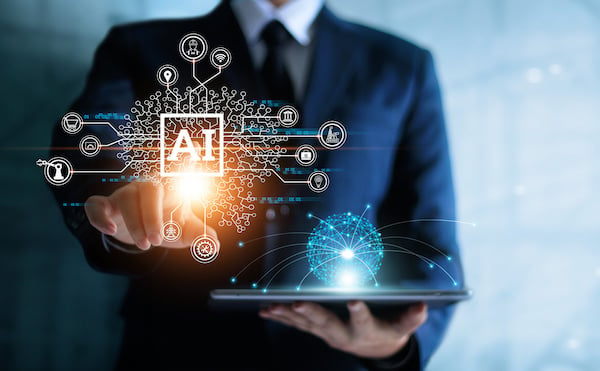Published on
AI Isn’t Coming for us Just Yet: What Humans Bring to the AI Equation
Athena Tassis | Research Assistant at the Next Level Lab, Harvard Graduate School of Education
Ashley Etemadi | Research Fellow at Next Level Lab, Harvard Graduate School of Education
Artificial intelligence (AI) is rapidly changing the workforce landscape. A recent survey of professionals across regions, tenures, industries, company sizes and functional specialties revealed that AI adoption has more than doubled in the last five years (Chui et al., 2022). With the introduction of large language models like ChatGPT, workers across the board are now accessing generative AI.
With these shifts, the skill sets necessary to be successful in the workplace have also evolved. An analysis conducted by McKinsey Global Institute found that more than 2000 work activities across 800 occupations have the potential to be automated, which will free up time for workers to tackle more challenging and creative endeavors and, in turn, alter the division of labor between humans and machines in the workplace (Lund et al., 2020; Brynjolfsson, Mitchell, & Rock, 2018).
As the landscape of work evolves, there is a need for a transformative relationship between humans and machines. In this context, humans and AI must engage in a symbiotic relationship, one in which a human and AI team produce superior outcomes compared to either working individually. We term this concept intelligence augmentation (IA).
To achieve IA, workers will have to leverage human judgment such as ethical reasoning and situational decision-making to complement the computational and predictive skills of their machine counterparts. The labor market has already seen a steady rise in the demand of judgment and decision-making skills over the last 50 years (Deming, 2021). Yet training for these skills has been sparse in the education and workforce development arenas. Preparing workers to engage in an economy demanding IA requires training and honing people’s judgment skills.
What Does Human Judgment Entail?
IA can be divided into two complementary components: reckoning and judgment (Cantwell Smith, 2019). Reckoning, which refers to calculative prediction and formulaic decision-making, is where AI systems particularly shine. For example, algorithms can extract emerging trends in the renewable energy sector from data such as purchasing trends and consumer preferences to determine potential profitability in certain markets.
These types of reckoning-related tasks within a job are strong contenders for automation. Other tasks, however, will probably not be replaced by AI anytime soon. These activities demand human judgment or wisdom, a form of deliberative thought that seeks to be unbiased, grounded in ethical commitment and contextually appropriate to the situation in which it is deployed (Dede, Etemadi & Forshaw, 2021).
Building upon the earlier example, a company that sells solar panels may use AI to recommend potential areas to market solar energy based on financial indicators and profitability, but humans can contribute valuable insight beyond monetary considerations. For instance, humans possess knowledge about the region’s culture and the attitudes of its inhabitants toward sustainability—variables that will significantly impact sales. This example highlights the importance of human judgment, which takes into consideration the various contextual factors that algorithms alone may not capture.
To further illustrate IA and the evolving division of labor between humans and AI, let’s look at the role of a customer service representative. Many companies over the last decade have switched to customer service chatbots, a software application for answering standard queries that conducts an online chat conversation through text or text-to-speech in lieu of contact with a live human agent. The implementation of chatbots has not, however, entirely removed the need for customer-facing personnel. Instead, the customer service calls that now reach agents typically involve more complex dilemmas, potentially requiring the ability to provide detailed explanations about specific cases and empathetic, culturally sensitive responses.
As these examples portray, human judgment involves a sophisticated suite of skill sets. We synthesize the broad categories of these capabilities unique to human beings that machine-based systems will not be able to emulate anytime soon into four defining areas: embodied, cultural, ethical and metacognitive reasoning (Cantwell Smith, 2019; Luckin, 2018).
Embodied
Our actions and bodily based experiences are often driven by embodied, contextual, experiential and meaning-laden knowledge, rather than simply observational and scientific knowledge. Even robots with lifelike bodies cannot engage with and respond to an environment and social settings with the richness and sensitivity that we can.
Cultural
Humans are shaped by and embedded in multiple layers of culture(s). We use a holistic assessment of context, attitude, tone of voice, connotation, body language and character, among other dimensions, to interpret and construct meaning. Each action factors in the complexities of human interactions and diverse backgrounds. AI, on the other hand, does not have the capacity to develop this sensitivity because it cannot experience culture in multidimensional and interconnected ways. Assuming that AI can develop this capability would disregard the nuances of lived experiences and imply that culturally sensitive responses can adhere to a formula.
Ethical
Humans have ethical frameworks and subjective values guided by consciousness and identity. Before acting, we readily take into consideration perceptions, interests, drives, values and social interactions. As many iterations of AI have demonstrated, machines will not be able to display a conscious perspective that incorporates moral implications and easily shifts to varying degrees dependent on the confluence of identities involved.
Metacognitive
We have the capability to consciously monitor, interpret and regulate our own mental thinking. If we are not certain, we add a disclaimer or conduct further research before delivering a final response. Machines, on the other hand, have no consciousness; they cannot reflect on their design or functions, despite being able to learn from patterns in large data sets. ChatGPT and other generative AI tools often go so far as fabricating information in order to meet the specifications of the prompts we feed them.
These four human capabilities are highly interconnected. The intricate connection between them becomes apparent when considering the influence of our bodily experiences within the contexts and cultures we inhabit. It is evident that our experiences are shaped by cultural and contextual influences that ultimately give us our initial values and opinions. Through metacognitive practices, we can critically examine and refine our beliefs, further shaping the trajectory of our identity over time. Conversely, our identities and moral constructs reciprocally shape our bodies’ reactions to certain stimuli and influence our decision-making process when interpreting these experiences.
Although some occupational frameworks identify human judgment and decision-making as soft skills, we believe these abilities to be their own unique category. Social, emotional, attitudinal and communication skills that shape social interactions shape how individuals interact with others. Judgment and decision-making rely on a combination of soft skills, contextual factors and potentially other types of information to determine a course of action. While strong soft skills are important for effective judgment, these two concepts should not be conflated.
For us to properly complement machines, we need more than just to possess these uniquely human capabilities. We must know how and when to leverage them to our advantage. This means that the dispositions for these capabilities, the tendencies to appropriately exercise them according to the occasion, are also an important component of IA.
Having textbook knowledge of ethical frameworks or cultural proclivities does not necessarily translate into action when the situation calls for human judgment. Learners also need to be able to identify instances when they need to deploy these capabilities, be inclined to engage them and understand how much of that skill or piece of knowledge is valuable in the situation. As such, we must not only possess these uniquely human skills but also identify when to use them appropriately and effectively.
Supporting Workers to Augment Their Work with Judgment Skills
Unfortunately, current educational practices will ensure machines replace workers in the coming years rather than foster IA. At present, the emphasis in upskilling and reskilling is primarily on developing reckoning capabilities that prioritize technical knowledge, data analysis and content retrieval, which are commonly associated with psychometric test taking and are skills replaceable by AI.
By focusing primarily on reckoning skills, workforce development programs neglect the vital role for human judgment and decision-making, which are needed for complex, context-specific tasks. As a result, employees may find themselves marginalized due to an increasingly AI-driven workforce. So, what can we do to better prepare workers?
Higher education institutions and workforce development organizations can play a crucial role in supporting workers through this change. They can build educational environments where uniquely human skills are valued, even when they cannot be as easily quantified as can reckoning skills. This can be achieved by supporting educators with the training and resources to properly incorporate these judgment-related skills into their curricula while also reviewing curricula to ensure these skills are embedded and assessed.
With respect to assessing judgment-related skills, educators need to rethink the formative and summative assessment methods currently used in classrooms and learning programs. Human judgment cannot be measured by the standardized assessments or multiple-choice tests that we administer today. Their formulaic and rote emphasis values reckoning skills in which AI excels. Instead, performance-based evaluations serve as more effective assessments, given that they factor in the contextual elements of judgment and allow learners to manifest their capabilities depending on the scenario at hand.
This form of assessment better showcases an individual’s skills and ultimately provides educators with key insights into a learners’ strengths and potential areas for improvement. Additionally, performance-based assessments cultivate a dynamic learning environment where individuals develop judgment skills through practical application and real-world experiences. By implementing curricula and assessments that capture the dynamism of judgment and decision-making skills, we will better support learners and workers in honing their capabilities.
A tangible skill and starting point for higher education institutions and workforce development to target would be the skill of negotiation. Negotiation is an interaction whereby the output of what two or more parties can do together is better than what they can do alone. It involves very personal and strategic communication with another party. Being able to practice negotiation through methods such as case studies and role plays can effectively teach and support workers to strengthen their ability to connect with others and can enable favorable outcomes in life situations that could propel their personal, professional and community-facing lives.
AI may have the ability to provide key points for a negotiation or ask a worker questions to consider during a negotiation, but it cannot reason, connect and build meaningful trust on a human level. Moreover, the technology cannot interpret subtle nonverbal cues, navigate cultural details or decode uncharacteristic changes in tone that make negotiations processes particularly sophisticated endeavors. These skills require the embodied, cultural, ethical and metacognitive abilities innate to humans.
While AI is transforming both the workforce and educational landscape, there are areas in which humans excel and may hold an advantage over machines. By valuing and highlighting the importance of these uniquely human skills, workforce development organizations and higher education institutions can better prepare individuals for a future job market that includes AI. Ultimately, developing a complementary role between machines and humans has already been fundamental in the current job market and will only increase in importance over the coming years.
References
Brynjolfsson, E., Mitchell, T., & Rock, D. (2018). What Can Machines Learn and What Does It Mean for Occupations and the Economy? AEA Papers and Proceedings, 108, 43–47. https://doi.org/10.1257/pandp.20181019
Cantwell Smith, B. (2019). Chapter 10: Reckoning and Judgment. In the Promise of Artificial Intelligence: Reckoning and Judgment (pp. 105–113). The MIT Press.
Chui, M., Hall, B., Mayhew, H., Singla, A., & Sukharevsky, A. (2022). The state of AI in 2022—and a half
decade in review. QuantumBlack By McKinsey.
Dede, C. Etemadi, A., & Forshaw, T. (2021). Intelligence augmentation: Upskilling humans to complement AI. The Next Level Lab at the Harvard Graduate School of Education. President and Fellows of Harvard College: Cambridge, MA.
Deming, D. J. (2021). The Growing Importance of Decision-Making on the Job. Harvard University and NBER. https://www.nber.org/papers/w28733
Luckin, R. (2018). Machine Learning and Human Intelligence: The Future of Education for the 21st Century. UCL Institute of Education Press.
Lund, S., Madgavkar, A., Manyika, J., & Smit, S. (2020, November 23). What’s next for Remote work: an
Analysis of 2,000 tasks, 800 jobs, and Nine Countries. McKinsey.
Author Perspective: Administrator



